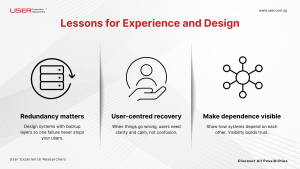What the AWS Outage Tells Us About Digital Resilience
For a few unsettling hours on 20 October 2025, large parts of the internet simply paused, creating uncertainty across the world for millions of people across timezones. Users opened apps that would not load. Websites they routinely visited disappeared. Behind the scenes, the cloud that quietly powers most of our digital world had faltered.
The AWS disruption didn’t just inconvenience users, it carried significant financial and operational consequences. Analysts estimate that major e-commerce platforms and streaming services lost millions in revenue during the downtime. Banks and fintech firms faced delayed transactions, while logistics networks relying on real-time cloud data experienced shipment delays. For global enterprises, even a few hours of outage can trigger cascading effects: missed SLAs, emergency IT costs, and reputational damage that erodes customer trust. This incident underscores how deeply business continuity depends on the digital resilience of cloud infrastructure.
How the Disruption Unfolded
At one of the largest data hubs of Amazon Web Services (AWS) known as US East 1, located in Northern Virginia in the United States, a problem occurred with the Domain Name System (DNS) that prevented apps and websites from finding correct addresses across the internet. This led to widespread DNS loading errors for all types of users and failure to load information. As a result, familiar services such as Snapchat, Fortnite, and banking platforms in the United Kingdom were knocked offline for many users.
The incident was a reminder that our always-on digital world depends on a few unseen systems working perfectly, every second of the day.
Real People, Real Impact
For many users, the event brought genuine disruption. A small business owner who relies on cloud-based email could not send invoices for hours. Students in the United Kingdom working on their online assignments suddenly lost access to their learning portals. Business platforms, some of them Amazon’s subsidiaries, also reported outages linked to AWS.
One major UK bank faced disrupted login services, while several telecom customers reported that their mobile apps had become unresponsive. None of these issues originated from the companies themselves, but from the shared cloud backbone they all used.
The impact of outages like this show how dependent the world has become on digital infrastructures, and why it’s important for businesses and organisations to ensure they have contingencies for such events.
What Experts Are Saying
“This outage once again highlights the dependency we have on relatively fragile infrastructures,” said Jake Moore, global cybersecurity advisor at ESET.
Professor Steven Murdoch from University College London added that “the incident appears to have been caused by some accident within AWS rather than being the result of any malicious intent.”
From a design and user experience perspective, the message is equally important. Reliability – that is, digital resilience, is now central to user trust. When systems fail silently, it is users who carry the weight of uncertainty.
Lessons for Experience and Design
This event gives organisations valuable lessons, even for those that are not primarily in technology.
Redundancy matters. If your service or product relies entirely on one region or one cloud provider, there is always a risk of a single point of failure. Digital resilience means having backup systems and strategies in the event of network or infrastructure downtimes.
User-centred recovery is crucial. When disruption happens, clear communication and smooth fallback options are as important as the technical fix itself. The user is always the most important part of a system, and their data is the most valuable.
Make dependence visible. Many product and UX teams assume the cloud will always work. This outage makes clear how much invisible infrastructure supports visible experiences.
A UX director who spoke at a design conference earlier this year summed it up well: “We create products so that users never have to worry. Maybe now, they will start to appreciate what keeps them connected.”
Designing for downtime is now as important as designing for uptime; that is what digital resilience is all about.
Looking Ahead: Building Stronger Digital Resilience
AWS has now restored its services and promised to publish a post-event summary.
For organisations, the lesson extends beyond this one incident. It is about shifting mindset from “Can we build it?” to “Can we withstand failure when it happens?”
If your product or service serves people who depend on it daily, building continuity into your experience design is no longer optional. It is part of what makes a truly human digital experience.
Events like the AWS outage remind us that progress does not come from complexity alone, but from the digital resilience of systems that can adapt, recover, and serve with empathy.
About User Experience Researchers Pte Ltd.
User Experience Researchers Pte Ltd (USER) is a leading UX-focused company specialising in digital transformation consultancy, agile development, and workforce solutions. We have a steadfast commitment to innovating the best of today’s technology to promote sustainable growth for businesses and industries.
For more information, contact USER through project@user.com.sg




